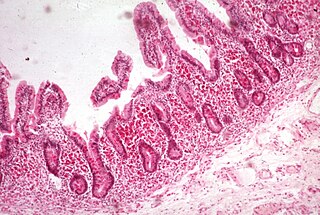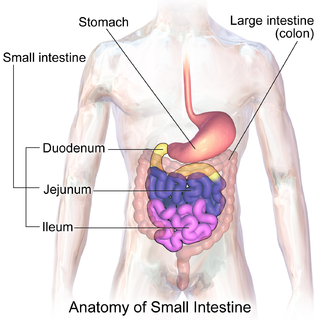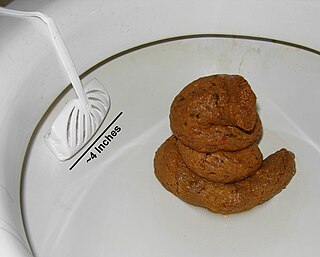Related Research Articles

Bile, or gall, is a yellow-green fluid produced by the liver of most vertebrates that aids the digestion of lipids in the small intestine. In humans, bile is primarily composed of water, produced continuously by the liver, and stored and concentrated in the gallbladder. After a human eats, this stored bile is discharged into the first section of their small intestine.

Fecal incontinence (FI), or in some forms, encopresis, is a lack of control over defecation, leading to involuntary loss of bowel contents, both liquid stool elements and mucus, or solid feces. When this loss includes flatus (gas), it is referred to as anal incontinence. FI is a sign or a symptom, not a diagnosis. Incontinence can result from different causes and might occur with either constipation or diarrhea. Continence is maintained by several interrelated factors, including the anal sampling mechanism, and incontinence usually results from a deficiency of multiple mechanisms. The most common causes are thought to be immediate or delayed damage from childbirth, complications from prior anorectal surgery, altered bowel habits. An estimated 2.2% of community-dwelling adults are affected. However, reported prevalence figures vary. A prevalence of 8.39% among non-institutionalized U.S adults between 2005 and 2010 has been reported, and among institutionalized elders figures come close to 50%.

Orlistat, sold under the brand name Xenical among others, is a medication used to treat obesity. Its primary function is preventing the absorption of fats from the human diet by acting as a lipase inhibitor, thereby reducing caloric intake. It is intended for use in conjunction with a healthcare provider-supervised reduced-calorie diet.
In medicine, the fecal fat test is a diagnostic test for fat malabsorption conditions, which lead to excess fat in the feces (steatorrhea).

Malabsorption is a state arising from abnormality in absorption of food nutrients across the gastrointestinal (GI) tract. Impairment can be of single or multiple nutrients depending on the abnormality. This may lead to malnutrition and a variety of anaemias.

Chronic pancreatitis is a long-standing inflammation of the pancreas that alters the organ's normal structure and functions. It can present as episodes of acute inflammation in a previously injured pancreas, or as chronic damage with persistent pain or malabsorption. It is a disease process characterized by irreversible damage to the pancreas as distinct from reversible changes in acute pancreatitis. Tobacco smoke and alcohol misuse are two of the most frequently implicated causes, and the two risk factors are thought to have a synergistic effect with regards to the development of chronic pancreatitis. Chronic pancreatitis is a risk factor for the development of pancreatic cancer.

Digestive enzymes take part in the chemical process of digestion, which follows the mechanical process of digestion. Food consists of macromolecules of proteins, carbohydrates, and fats that need to be broken down chemically by digestive enzymes in the mouth, stomach, pancreas, and duodenum, before being able to be absorbed into the bloodstream. Initial breakdown is achieved by chewing (mastication) and the use of digestive enzymes of saliva. Once in the stomach further mechanical churning takes place mixing the food with secreted gastric acid. Digestive gastric enzymes take part in some of the chemical process needed for absorption. Most of the enzymatic activity, and hence absorption takes place in the duodenum.

Gastrointestinal diseases refer to diseases involving the gastrointestinal tract, namely the esophagus, stomach, small intestine, large intestine and rectum, and the accessory organs of digestion, the liver, gallbladder, and pancreas.

Pancreatic enzymes, also known as pancreases or pancrelipase and pancreatin, are commercial mixtures of amylase, lipase, protease and lactase. They are used to treat malabsorption syndrome due to certain pancreatic problems. These pancreatic problems may be due to cystic fibrosis, surgical removal of the pancreas, long term pancreatitis, pancreatic cancer, or MODY 5, among others. The preparation is taken by mouth.

Lingual lipase is a member of a family of digestive enzymes called triacylglycerol lipases, EC 3.1.1.3, that use the catalytic triad of aspartate, histidine, and serine to hydrolyze medium and long-chain triglycerides into partial glycerides and free fatty acids. The enzyme, released into the mouth along with the saliva, catalyzes the first reaction in the digestion of dietary lipid, with diglycerides being the primary reaction product. However, due to the unique characteristics of lingual lipase, including a pH optimum 4.5–5.4 and its ability to catalyze reactions without bile salts, the lipolytic activity continues through to the stomach. Enzyme release is signaled by autonomic nervous system after ingestion, at which time the serous glands under the circumvallate and foliate lingual papillae on the surface of the tongue secrete lingual lipase to the grooves of the circumvallate and foliate papillae, co-localized with fat taste receptors. The hydrolysis of the dietary fats is essential for fat absorption by the small intestine, as long chain triacylglycerides cannot be absorbed, and as much as 30% of fat is hydrolyzed within 1 to 20 minutes of ingestion by lingual lipase alone.

Blind loop syndrome, also known as stagnant loop syndrome, is a state that occurs when the normal bacterial flora of the small intestine proliferates to numbers that cause significant derangement to the normal physiological processes of digestion and absorption. In some cases of blind loop syndrome, overgrowth of pathogenic non-commensal bacteria has also been noted. It has long been understood that from birth, and throughout life, large amounts of bacteria reside symbiotically within animal gastrointestinal tracts such as the human gastrointestinal tract. The understanding of this gut flora has even led to novel treatments for bowel irregularity that utilize so called "probiotics" or good bacteria that aid in normal digestion. The problem of blind loop syndrome arises when the bacterial colonies residing in the upper gastrointestinal tract begin to grow out of control or are altered in their makeup thereby creating a burden on the normal physiological processes occurring in the small intestine. This results in problems, among others, of: vitamin B12 deficiency, fat malabsorption and steatorrhea, fat-soluble vitamin deficiencies and intestinal wall injury.

Exocrine pancreatic insufficiency (EPI) is the inability to properly digest food due to a lack or reduction of digestive enzymes made by the pancreas. EPI can occur in humans and is prevalent in many conditions such as cystic fibrosis, Shwachman–Diamond syndrome, different types of pancreatitis, multiple types of diabetes mellitus, advanced renal disease, older adults, celiac disease, IBS-D, IBD, HIV, alcohol-related liver disease, Sjogren syndrome, tobacco use, and use of somatostatin analogues.
Pancreatic diseases are diseases that affect the pancreas, an organ in most vertebrates and in humans and other mammals located in the abdomen. The pancreas plays a role in the digestive and endocrine system, producing enzymes which aid the digestion process and the hormone insulin, which regulates blood sugar levels. The most common pancreatic disease is pancreatitis, an inflammation of the pancreas which could come in acute or chronic form. Other pancreatic diseases include diabetes mellitus, exocrine pancreatic insufficiency, cystic fibrosis, pseudocysts, cysts, congenital malformations, tumors including pancreatic cancer, and hemosuccus pancreaticus.

Human feces are the solid or semisolid remains of food that could not be digested or absorbed in the small intestine of humans, but has been further broken down by bacteria in the large intestine. It also contains bacteria and a relatively small amount of metabolic waste products such as bacterially altered bilirubin, and the dead epithelial cells from the lining of the gut. It is discharged through the anus during a process called defecation.
Cetilistat is a drug designed to treat obesity. It acts in the same way as the older drug orlistat (Xenical) by inhibiting pancreatic lipase, an enzyme that breaks down triglycerides in the intestine. Without this enzyme, triglycerides from the diet are prevented from being hydrolyzed into absorbable free fatty acids and are excreted undigested.
Steatocrit or acid steatocrit is a simple, rapid gravimetric method to determine steatorrhea. The test is simple, rapid, inexpensive, and reliable. It is a qualitative test that can be used when other methods are impractical.
Bile acid malabsorption (BAM), known also as bile acid diarrhea, is a cause of several gut-related problems, the main one being chronic diarrhea. It has also been called bile acid-induced diarrhea, cholerheic or choleretic enteropathy, bile salt diarrhea or bile salt malabsorption. It can result from malabsorption secondary to gastrointestinal disease, or be a primary disorder, associated with excessive bile acid production. Treatment with bile acid sequestrants is often effective. It is recognised as a disability in the United Kingdom under the Equality Act 2010

Lipase inhibitors are substances used to reduce the activity of lipases found in the intestine. Lipases are secreted by the pancreas when fat is present. The primary role of lipase inhibitors is to decrease the gastrointestinal absorption of fats. Fats then tend to be excreted in feces rather than being absorbed to be used as a source of caloric energy, and this can result in weight loss in individuals. These inhibitors could be used for the treatment of obesity, which can subsequently lead to Type 2 diabetes and cardiovascular diseases if not managed. An example of a lipase inhibitor is orlistat.

The human digestive system consists of the gastrointestinal tract plus the accessory organs of digestion. Digestion involves the breakdown of food into smaller and smaller components, until they can be absorbed and assimilated into the body. The process of digestion has three stages: the cephalic phase, the gastric phase, and the intestinal phase.

Lipase inhibitors belong to a drug class that is used as an antiobesity agent. Their mode of action is to inhibit gastric and pancreatic lipases, enzymes that play an important role in the digestion of dietary fat. Lipase inhibitors are classified in the ATC-classification system as A08AB . Numerous compounds have been either isolated from nature, semi-synthesized, or fully synthesized and then screened for their lipase inhibitory activity but the only lipase inhibitor on the market is orlistat . Lipase inhibitors have also shown anticancer activity, by inhibiting fatty acid synthase.
References
- 1 2 3 4 5 6 7 Adam S Cheifetz, Alphonso Brown, Michael Curry, Alan C Moss (10 Mar 2011). Oxford American Handbook of Gastroenterology and Hepatology. Oxford University Press. p. 234. ISBN 978-0-19-983012-1.
- 1 2 3 4 Azer SA, Sankararaman S (January 2021). Steatorrhea. Treasure Island (FL): StatPearls Publishing. PMID 31082099 . Retrieved 3 October 2021.
- ↑ Lindkvist B (2013). "Diagnosis and treatment of pancreatic exocrine insufficiency". World J. Gastroenterol. (Review). 19 (42): 7258–66. doi: 10.3748/wjg.v19.i42.7258 . PMC 3831207 . PMID 24259956.
- ↑ Moutzouri E, Elisaf M, Liberopoulos NE (2011). "Hypocholesterolemia". Current Vascular Pharmacology. 9 (2): 200–12. doi:10.2174/157016111794519354. PMID 20626336.
- ↑ Dogliotti L, Tampellini M, Stivanello M, Gorzegno G, Fabiani L (2001). "The clinical management of neuroendocrine tumors with long-acting repeatable (LAR) octreotide: comparison with standard subcutaneous octreotide therapy". Annals of Oncology. 12 (Suppl 2): S105–9. doi:10.1093/annonc/12.suppl_2.s105. PMID 11762334.
- 1 2 Squires S (2006-01-24). "Weighing a Pill For Weight Loss". Washington Post . Retrieved 2007-07-06.
While the Food and Drug Administration (FDA) still must approve the switch, the agency often follows the advice of its experts. If it does, Orlistat (xenical) -- currently sold only by prescription -- could be available over-the-counter (OTC) later this year. But it's important to know that the weight loss that's typical for users of the drug -- 5 to 10 percent of total weight -- will be less than many dieters expect. And many consumers may be put off by the drug's significant gastrointestinal side effects, including flatulence, diarrhea, and anal leakage.
- 1 2 "Frito-Lay Study: Olestra Causes "Anal Oil Leakage"". Center for Science in the Public Interest. February 13, 1997. Archived from the original on 2016-06-18. Retrieved 2007-07-07.
The Frito-Lay report states: "The anal oil leakage symptoms were observed in this study (3 to 9% incidence range above background), as well as other changes in elimination. ... Underwear spotting was statistically significant in one of two low-level consumer groups at a 5% incidence above background." Despite those problems, the authors of the report concluded that olestra-containing snacks "should have a high potential for acceptance in the marketplace."
- 1 2 "The Word Is 'Leakage'. Accidents may happen with a new OTC diet drug". Newsweek. June 25, 2007. Archived from the original on 2007-06-18. Retrieved 2007-06-21.
GlaxoSmithKline has a tip for people who decide to try Alli, the over-the-counter weight-loss drug it is launching with a multimillion-dollar advertising blitz—keep an extra pair of pants handy. That's because Alli, a lower-dose version of the prescription drug Xenical, could (cue the late-night talk-show hosts) make you soil your pants. But while Alli's most troublesome side effect, anal leakage, is sure to be good for a few laughs, millions of people who are desperate to take off weight may still decide the threat of an accident is worth it.
- ↑ Traoret CJ, Lokko P, Cruz AC, Oliveira CG, Costa NM, Bressan J, Alfenas RC, Mattes RD (2007). "Peanut digestion and energy balance". International Journal of Obesity. 32 (2): 322–8. doi:10.1038/sj.ijo.0803735. PMID 17912269.
- ↑ Hollis J, Mattes R (2007). "Effect of chronic consumption of almonds on body weight in healthy humans". British Journal of Nutrition. 98 (3): 651–6. doi: 10.1017/S0007114507734608 . PMID 17445351.
- ↑ Place AR (1992). "Comparative aspects of lipid digestion and absorption: Physiological correlates of wax ester digestion". The American Journal of Physiology. 263 (3 Pt 2): R464–71. doi:10.1152/ajpregu.1992.263.3.R464. PMID 1415629.
- ↑ Bad Bug Book - Foodborne Pathogenic Microorganisms and Natural Toxins Handbook: Gempylotoxin, FDA
- ↑ "Reported medical side-effects of Olestra according to Procter and Gamble studies". Center for Science in the Public Interest. Archived from the original on 2007-07-02. Retrieved 2007-06-21.
Olestra sometimes causes underwear staining associated with "anal leakage." Olestra sometimes causes underwear staining. That phenomenon may be caused most commonly by greasy, hard-to-wipe-off fecal matter, but occasionally also from anal leakage (leakage of liquid olestra through the anal sphincter).
- 1 2 Lindkvist B (14 November 2013). "Diagnosis and treatment of pancreatic exocrine insufficiency". World Journal of Gastroenterology. 19 (42): 7258–66. doi: 10.3748/wjg.v19.i42.7258 . PMC 3831207 . PMID 24259956.
- ↑ Rubio-Tapia A, Hill ID, Kelly CP, Calderwood AH, Murray JA, American College of G (May 2013). "ACG clinical guidelines: diagnosis and management of celiac disease". The American Journal of Gastroenterology. 108 (5): 656–76, quiz 677. doi:10.1038/ajg.2013.79. PMC 3706994 . PMID 23609613.